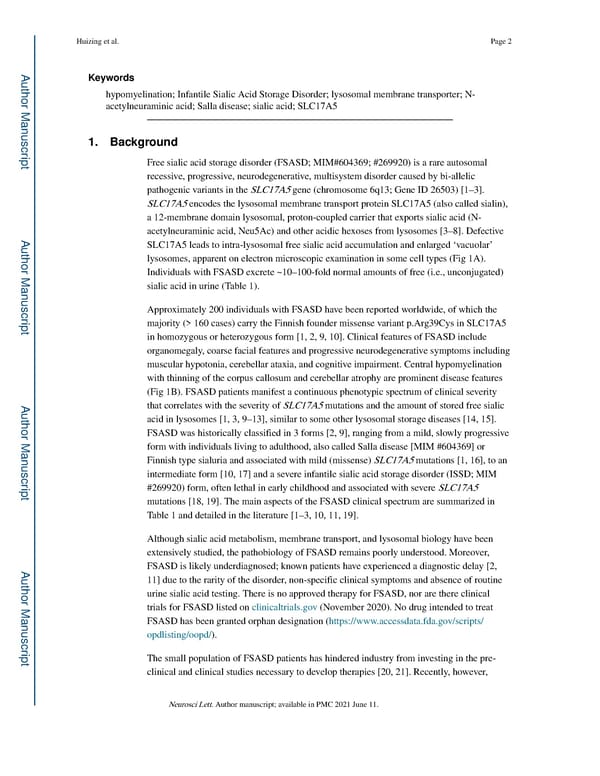Huizing et al. Page 2 A Keywords uthor Man hypomyelination; Infantile Sialic Acid Storage Disorder; lysosomal membrane transporter; N- acetylneuraminic acid; Salla disease; sialic acid; SLC17A5 uscr 1. Background ipt Free sialic acid storage disorder (FSASD; MIM#604369; #269920) is a rare autosomal recessive, progressive, neurodegenerative, multisystem disorder caused by bi-allelic pathogenic variants in the SLC17A5 gene (chromosome 6q13; Gene ID 26503) [1–3]. SLC17A5 encodes the lysosomal membrane transport protein SLC17A5 (also called sialin), a 12-membrane domain lysosomal, proton-coupled carrier that exports sialic acid (N- acetylneuraminic acid, Neu5Ac) and other acidic hexoses from lysosomes [3–8]. Defective A uthor Man SLC17A5 leads to intra-lysosomal free sialic acid accumulation and enlarged ‘vacuolar’ lysosomes, apparent on electron microscopic examination in some cell types (Fig 1A). Individuals with FSASD excrete ~10–100-fold normal amounts of free (i.e., unconjugated) sialic acid in urine (Table 1). uscr Approximately 200 individuals with FSASD have been reported worldwide, of which the ipt majority (> 160 cases) carry the Finnish founder missense variant p.Arg39Cys in SLC17A5 in homozygous or heterozygous form [1, 2, 9, 10]. Clinical features of FSASD include organomegaly, coarse facial features and progressive neurodegenerative symptoms including muscular hypotonia, cerebellar ataxia, and cognitive impairment. Central hypomyelination with thinning of the corpus callosum and cerebellar atrophy are prominent disease features (Fig 1B). FSASD patients manifest a continuous phenotypic spectrum of clinical severity A that correlates with the severity of SLC17A5 mutations and the amount of stored free sialic uthor Man acid in lysosomes [1, 3, 9–13], similar to some other lysosomal storage diseases [14, 15]. FSASD was historically classified in 3 forms [2, 9], ranging from a mild, slowly progressive form with individuals living to adulthood, also called Salla disease [MIM #604369] or Finnish type sialuria and associated with mild (missense) SLC17A5 mutations [1, 16], to an uscr intermediate form [10, 17] and a severe infantile sialic acid storage disorder (ISSD; MIM ipt #269920) form, often lethal in early childhood and associated with severe SLC17A5 mutations [18, 19]. The main aspects of the FSASD clinical spectrum are summarized in Table 1 and detailed in the literature [1–3, 10, 11, 19]. Although sialic acid metabolism, membrane transport, and lysosomal biology have been extensively studied, the pathobiology of FSASD remains poorly understood. Moreover, FSASD is likely underdiagnosed; known patients have experienced a diagnostic delay [2, A uthor Man 11] due to the rarity of the disorder, non-specific clinical symptoms and absence of routine urine sialic acid testing. There is no approved therapy for FSASD, nor are there clinical trials for FSASD listed on clinicaltrials.gov (November 2020). No drug intended to treat FSASD has been granted orphan designation (https://www.accessdata.fda.gov/scripts/ uscr opdlisting/oopd/). ipt The small population of FSASD patients has hindered industry from investing in the pre- clinical and clinical studies necessary to develop therapies [20, 21]. Recently, however, Neurosci Lett. Author manuscript; available in PMC 2021 June 11.
 Free Sialic Acid Storage Disorder: Progress and Promise Page 1 Page 3
Free Sialic Acid Storage Disorder: Progress and Promise Page 1 Page 3